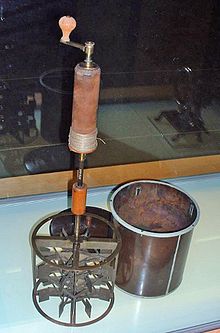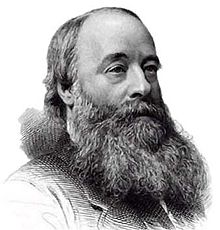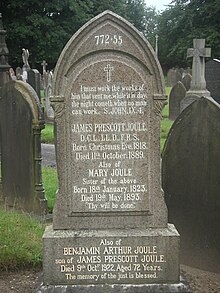Sir Isaac Newton
Sir Isaac Newton is considered by some to be the most influential man in the history of science, more so than even Albert Einstein.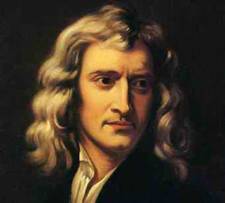 |
||
| Date of Birth: 1/4/1643 | Date of Death: 3/31/1727 | |
| Birthplace: Woolsthorpe-by-Colsterworth Lincolnshire, England | ||
Famous Work: Newton's Laws of Motion
In addition to his vast contributions to the fields of mathematics, Newton is also credited with the development of many topics in, among other things, philosophy, astronomy, and physics. You may have heard of Newton's Laws of Motion, in particular his first and third laws (paraphrased below).
First Law: an object in motion stays in motion, and an object at rest stays at rest unless and external forces acts upon it.
Second Law: The equation F = ma, where m is the mass of the object, F is the net force, and a is the acceleration.
Third Law: for every action there is an equal and opposite reaction.
Albert Einstein Biography & Pictures
Only the individual can think, and thereby
create new values for society, nay, even set up new moral standards to which
the life of the community conforms. ... The ideals which have lighted my
way, and time after time have given me new courage to face life cheerfully,
have been Kindness, Beauty and Truth. (Albert Einstein,
1954)
Albert Einstein (March 14, 1879 - April 18, 1955) was
a theoretical physicist who is widely regarded as the greatest scientist
of the 20th century. He proposed the theory of relativity and also made
major contributions to the development of quantum mechanics, statistical
mechanics, and cosmology. He was awarded the 1921 Nobel Prize for Physics
for his explanation of the photoelectric effect and "for his services
to Theoretical Physics".Youth and Education
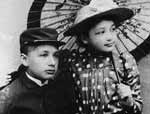 Einstein
was born at Ulm in Württemberg, Germany; about 100 km east of Stuttgart.
His family was Jewish (and non-observant); Albert attended a Catholic elementary
school and, at the insistence of his mother, was given violin lessons.
Einstein
was born at Ulm in Württemberg, Germany; about 100 km east of Stuttgart.
His family was Jewish (and non-observant); Albert attended a Catholic elementary
school and, at the insistence of his mother, was given violin lessons.Einstein began to learn mathematics around age twelve. In 1894, following the failure of his fathers electrochemical business, the Einstein's moved from Munich to Pavia, Italy (near Milan). Albert remained behind to finish school, completing a term by himself before rejoining his family in Pavia.
His failure of the liberal arts portion of the Eidgenössische Technische Hochschule (Swiss Federal Institute of Technology, in Zurich) entrance exam the following year was a setback; he was sent by his family to Aarau, Switzerland, to finish secondary school, where he received his diploma in 1896. Einstein subsequently enrolled at the Eidgenössische Technische Hochschule. The same year, he renounced his Württemberg citizenship, becoming stateless.
In 1898, Einstein met and fell in love with Mileva Maric, a Serbian classmate (and friend of Nikola Tesla). In 1900, he was granted a teaching diploma by the Eidgenössische Technische Hochschule and was accepted as a Swiss citizen in 1901. During this time Einstein discussed his scientific interests with a group of close friends, including Mileva. He and Mileva had a daughter Lieserl, born in January, 1902. Lieserl, at the time, was considered illegitimate because the parents were unwed.
Work and doctorate
Upon graduation, Einstein could not find a teaching post. The father of a classmate helped him obtain employment as a technical assistant examiner at the Swiss Patent Office in 1902.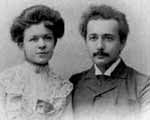 Einstein
married Mileva on January 6, 1903. Einstein's marriage to Mileva, who was
a mathematician, was both a personal and intellectual partnership: Einstein
referred lovingly, or perhaps with some chagrin, to Mileva as "a creature
who is my equal and who is as strong and independent as I am".
Einstein
married Mileva on January 6, 1903. Einstein's marriage to Mileva, who was
a mathematician, was both a personal and intellectual partnership: Einstein
referred lovingly, or perhaps with some chagrin, to Mileva as "a creature
who is my equal and who is as strong and independent as I am".On May 14, 1904, the couple's first son, Hans Albert Einstein, was born. In 1904, Einstein's position at the Swiss Patent Office was made permanent. He obtained his doctorate after submitting his thesis "On a new determination of molecular dimensions" in 1905.
That same year, he wrote four articles that provided the foundation of modern physics, without much scientific literature to which he could refer or many scientific colleagues with whom he could discuss the theories. Most physicists agree that three of those papers (on Brownian motion, the photoelectric effect, and special relativity) deserved Nobel Prizes. Only the paper on the photoelectric effect would win one. This is ironic, not only because Einstein is far better-known for relativity, but also because the photoelectric effect is a quantum phenomenon, and Einstein became somewhat disenchanted with the path quantum theory would take. What makes these papers remarkable is that, in each case, Einstein boldly took an idea from theoretical physics to its logical consequences and managed to explain experimental results that had baffled scientists for decades.
He submitted these papers to the "Annalen der Physik". They are commonly referred to as the "Annus Mirabilis Papers" (from Latin: Extraordinary Year). The International Union of Pure and Applied Physics (IUPAP) plans to commemorate the 100th year of the publication of Einstein's extensive work in 1905 as the 'World Year Of Physics 2005'.
Brownian motion
 His first article in 1905, named "On the Motion—Required by the
Molecular Kinetic Theory of Heat—of Small Particles Suspended in a
Stationary Liquid", covered his study of Brownian motion. Using the
then-controversial kinetic theory of fluids, it established that the phenomenon,
which still lacked a satisfactory explanation decades after it was first
observed, provided empirical evidence for the reality of atoms. It also
lent credence to statistical mechanics, which was also controversial at
the time.
His first article in 1905, named "On the Motion—Required by the
Molecular Kinetic Theory of Heat—of Small Particles Suspended in a
Stationary Liquid", covered his study of Brownian motion. Using the
then-controversial kinetic theory of fluids, it established that the phenomenon,
which still lacked a satisfactory explanation decades after it was first
observed, provided empirical evidence for the reality of atoms. It also
lent credence to statistical mechanics, which was also controversial at
the time.Before this paper, atoms were recognized as a useful concept, but physicists and chemists hotly debated whether atoms were real entities. Einstein's statistical discussion of atomic behaviour gave experimentalists a way to count atoms by looking through an ordinary microscope. Wilhelm Ostwald, one of the leaders of the anti-atom school, later told Arnold Sommerfeld that he had been converted to a belief in atoms by Einstein's complete explanation of Brownian motion.
Photoelectric effect
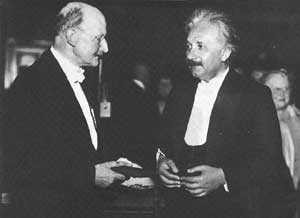 The
second paper, named "On a Heuristic Viewpoint Concerning the Production
and Transformation of Light", proposed the idea of "light quanta"
(now called photons) and showed how it could be used to explain such phenomena
as the photoelectric effect. The idea of light quanta was motivated by Max
Planck's earlier derivation of the law of black-body radiation by assuming
that luminous energy could only be absorbed or emitted in discrete amounts,
called quanta. Einstein showed that, by assuming that light actually consisted
of discrete packets, he could explain the mysterious photoelectric effect.
The
second paper, named "On a Heuristic Viewpoint Concerning the Production
and Transformation of Light", proposed the idea of "light quanta"
(now called photons) and showed how it could be used to explain such phenomena
as the photoelectric effect. The idea of light quanta was motivated by Max
Planck's earlier derivation of the law of black-body radiation by assuming
that luminous energy could only be absorbed or emitted in discrete amounts,
called quanta. Einstein showed that, by assuming that light actually consisted
of discrete packets, he could explain the mysterious photoelectric effect.The idea of light quanta contradicted the wave theory of light that followed naturally from James Clerk Maxwell's equations for electromagnetic behaviour and, more generally, the assumption of infinite divisibility of energy in physical systems. Even after experiments showed that Einstein's equations for the photoelectric effect were accurate, his explanation was not universally accepted. However, by 1921, when he was awarded the Nobel Prize and his work on photoelectricity was mentioned by name in the award citation, most physicists thought that the equation (hf = Φ + Ek) was correct and light quanta were possible.
The theory of light quanta was a strong indication of wave-particle duality, the concept, used as a fundamental principle by the creators of quantum mechanics, that physical systems can display both wave-like and particle-like properties. A complete picture of the photoelectric effect was only obtained after the maturity of quantum mechanics.
Special relativity
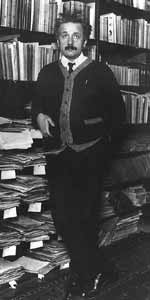 Einstein's
third paper that year was called "On the Electrodynamics of Moving
Bodies". While developing this paper, Einstein wrote to Mileva about
"our work on relative motion", and this has led some to ask whether
Mileva played a part in its development. This paper introduced the special
theory of relativity, a theory of time, distance, mass and energy which
was consistent with electromagnetism, but omitted the force of gravity.
Einstein's
third paper that year was called "On the Electrodynamics of Moving
Bodies". While developing this paper, Einstein wrote to Mileva about
"our work on relative motion", and this has led some to ask whether
Mileva played a part in its development. This paper introduced the special
theory of relativity, a theory of time, distance, mass and energy which
was consistent with electromagnetism, but omitted the force of gravity.Special relativity solved the puzzle that had been apparent since the Michelson-Morley experiment, which had shown that light waves did not travel through a medium unlike other known waves which require a medium such as water or air. The speed of light was thus fixed, and not relative to the movement of the observer. This was impossible under Newtonian classical mechanics.
It had already been conjectured by George Fitzgerald in 1894 that the Michelson-Morley result could be accounted for if moving bodies were squashed in the direction of their motion. Indeed, some of the paper's core equations, the Lorentz transforms, had been introduced in 1903 by Dutch physicist Hendrik Lorentz, giving mathematical form to Fitzgerald's conjecture. But Einstein revealed the underlying reasons for this geometrical oddity.
His explanation arose from two axioms: Galileo's old idea that the laws of nature should be the same for all observers that move with constant speed relative to each other, and the rule that the speed of light is the same for every observer. Special relativity has several striking consequences, because the absolute concepts of time and size are rejected. The theory came to be called the "special theory of relativity" to distinguish it from his later theory of general relativity, which considers all observers to be equivalent.
Energy equivalence
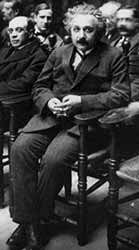 A
fourth paper, "Does the Inertia of a Body Depend Upon Its Energy Content?",
published late in 1905, showed one further deduction from relativity's axioms,
the famous equation that the energy of a body at rest (E) equals its mass
(m) times the speed of light (c) squared:E = mc2
A
fourth paper, "Does the Inertia of a Body Depend Upon Its Energy Content?",
published late in 1905, showed one further deduction from relativity's axioms,
the famous equation that the energy of a body at rest (E) equals its mass
(m) times the speed of light (c) squared:E = mc2 Einstein considered this equation to be of paramount importance because it showed that a massive particle possesses an energy, the "rest energy", distinct from its classical kinetic and potential energies. Nevertheless, most scientists simply regarded the finding as a curiosity until the 1930s.
The mass-energy relation can be used to predict how much energy will be released or consumed by chemical and nuclear reactions; one simply measures the mass of all constituents and products and multiplies the difference by c². The result shows how much energy will be released or consumed, usually in the form of light or heat. If applied to certain nuclear reactions, the equation shows that an extraordinary large amount of energy will be released, much larger than in the combustion of chemical explosives, where the mass difference hardly measurable at all. This explains why nuclear weapons produce such phenomenal amounts of energy.
Middle years
In 1906, Albert Einstein was promoted to technical examiner second class. In 1908, Einstein was licensed in Bern, Switzerland as a Privatdozent (unsalaried teacher at a university). Einstein's second son, Eduard, was born on July 28, 1910.In 1911, Einstein became a full professor at the University of Prague. At that time, he worked closely with the mathematician Marcel Grossman. In 1912, Einstein started to refer to time as the fourth dimension.
In 1914, just before the start of World War I, Einstein settled in Berlin as professor at the local university and became a member of the Prussian Academy of Sciences. His pacifism and Jewish origins irritated German nationalists. After he became world-famous, nationalistic hatred of him grew and for the first time he was the subject of an organized campaign to discredit his theories.
From 1914 to 1933, he served as director of the Kaiser Wilhelm Institute for Physics in Berlin, and it was during this time that he was awarded his Nobel Prize and made his most groundbreaking discoveries.
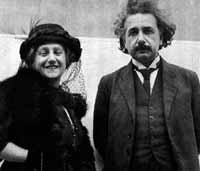 Einstein
divorced Mileva on February 14, 1919, and married his cousin Elsa Loewenthal
(née Einstein: Loewenthal was the surname of her first husband, Max)
on June 2, 1919. Elsa was Albert's first cousin (maternally) and his second
cousin (paternally). She was three years older than Albert, and had nursed
him to health after he had suffered a partial nervous breakdown combined
with a severe stomach ailment. There were no children from this marriage.
Einstein
divorced Mileva on February 14, 1919, and married his cousin Elsa Loewenthal
(née Einstein: Loewenthal was the surname of her first husband, Max)
on June 2, 1919. Elsa was Albert's first cousin (maternally) and his second
cousin (paternally). She was three years older than Albert, and had nursed
him to health after he had suffered a partial nervous breakdown combined
with a severe stomach ailment. There were no children from this marriage.In 1922, Einstein and his wife Elsa boarded the S.S. Kitano Maru bound for Japan. The trip also took them to other ports including Singapore, Hong Kong and Shanghai.
The fate of Albert and Mileva's first child, Lieserl, is unknown: some believe she died in infancy, while others believe she was given out for adoption. Eduard was institutionalized for schizophrenia and died in an asylum, while Hans became a professor of hydraulic engineering at the University of California, Berkeley, having little interaction with his father.
General relativity
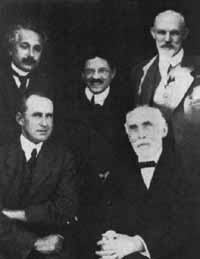 In
November, 1915, Einstein presented a series of lectures before the Prussian
Academy of Sciences in which he described his theory of general relativity.
The final lecture climaxed with his introduction of an equation that replaced
Newton's law of gravity. This theory considered all observers to be equivalent,
not only those moving at a uniform speed. In general relativity, gravity
is no longer a force (as it is in Newton's law of gravity) but is a consequence
of the curvature of space-time.
In
November, 1915, Einstein presented a series of lectures before the Prussian
Academy of Sciences in which he described his theory of general relativity.
The final lecture climaxed with his introduction of an equation that replaced
Newton's law of gravity. This theory considered all observers to be equivalent,
not only those moving at a uniform speed. In general relativity, gravity
is no longer a force (as it is in Newton's law of gravity) but is a consequence
of the curvature of space-time.The theory provided the foundation for the study of cosmology and gave scientists the tools for understanding many features of the universe that were discovered well after Einstein's death. A truly revolutionary theory, general relativity has passed every test till now – unlike many other scientific theories – and become a method of perceiving all of physics.
Initially, scientists were skeptical because the theory was derived by mathematical reasoning and rational analysis, not by experiment or observation. But in 1919, predictions made using the theory were confirmed by Arthur Eddington's measurements (during a solar eclipse), of how much the light emanating from a star was bent by the Sun's gravity when it passed close to the Sun. On November 7, The Times reported the confirmation, cementing Einstein's fame.
However, many scientists were still unconvinced for various reasons, ranging from disagreement with Einstein's interpretation of the experiments, to not being able to tolerate the absence of an absolute frame of reference. In Einstein's view, many of them simply could not understand the mathematics involved. Einstein's public fame which followed the 1919 article created resentment among these scientists, some of which lasted well into the 1930s.
In the early 1920s, Einstein was the lead figure in a famous weekly physics colloquium at the University of Berlin. On March 30, 1921, Einstein went to New York to give a lecture on his new theory. In the same year, he was finally awarded the Nobel Prize. Though he is now most famous for his work on relativity, it was for his earlier work on the photoelectric effect that he was given the Prize, because in his work on relativity was still disputed and the Nobel committee decided that citing his less-contested theory would be a better political move.
The "Copenhagen" interpretation
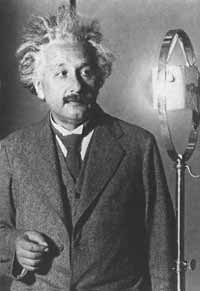 Einstein's
relationship with quantum physics was quite remarkable. He was the first
to say that quantum theory was revolutionary. His idea of light quanta,
now known as photons, marked a landmark break with the classical physics.
In 1909, Einstein presented his first paper to a gathering of physicists
and told them that they must find some way to understand waves and particles
together.
Einstein's
relationship with quantum physics was quite remarkable. He was the first
to say that quantum theory was revolutionary. His idea of light quanta,
now known as photons, marked a landmark break with the classical physics.
In 1909, Einstein presented his first paper to a gathering of physicists
and told them that they must find some way to understand waves and particles
together.In the mid-1920s, as the original quantum theory was replaced with a new quantum mechanics, Einstein balked at the Copenhagen interpretation of the new equations because it settled for a probabilistic, non-visualizable account of physical behaviour Einstein agreed that the theory was the best available, but he looked for a more "complete" explanation, i.e. more deterministic. He could not abandon the belief that physics described the laws that govern "real things", the belief which had led to his successes with atoms, photons, and gravity (though he did not believe in 'particles', but rather, represented matter as continuous fields in space-time, the 'particle' only appearing as a high energy density region of space).
In a 1926 letter to Max Born, Einstein made a remark that is now famous:
Quantum mechanics is certainly imposing. But an inner voice
tells me it is not yet the real thing. The theory says a lot, but does not
really bring us any closer to the secret of the Old One. I, at any rate,
am convinced that He does not throw dice.
To this, Niels Bohr, who sparred with Einstein on quantum theory retorted,
Stop telling God what He must do!
It was not a rejection of probabilistic theories per se—Einstein
had used statistical analysis in his work on Brownian motion and photoelectricity,
and in papers published before the miraculous year 1905, and had even discovered
Gibbs ensembles on his own—but he believed that, at the core, physical
reality behaved deterministically.Recent controversial results seem to lend support to Einstein's misgivings about the orthodox interpretation of quantum mechanics. In March, 2004, the results of the Afshar experiment were published which, it is claimed, disprove Bohr's Principle of Complementarity, one of the foundations of the Copenhagen interpretation.
Bose-Einstein statistics
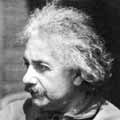 In
1924, Einstein received a short paper from a young Indian physicist named
Satyendra Nath Bose describing light as a gas of photons and asking for
Einstein's assistance in publication. Einstein realised that the same statistics
could be applied to atoms, and published an article in German (then the
lingua franca of physics) which described Bose's model and explained its
implications. Bose-Einstein statistics now describe any assembly of these
indistinguishable particles known as bosons.
In
1924, Einstein received a short paper from a young Indian physicist named
Satyendra Nath Bose describing light as a gas of photons and asking for
Einstein's assistance in publication. Einstein realised that the same statistics
could be applied to atoms, and published an article in German (then the
lingua franca of physics) which described Bose's model and explained its
implications. Bose-Einstein statistics now describe any assembly of these
indistinguishable particles known as bosons.Einstein also assisted Erwin Schrödinger in the development of the Quantum Boltzmann distribution, a mixed classical and quantum mechanical gas model—although he realised that this was less significant than the Bose-Einstein model, and declined to have his name included on the paper.
Later Years
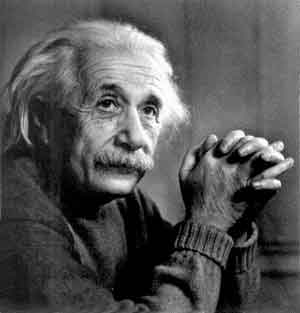 Einstein
spent the last fourteen years of his life trying to unify gravity and electromagnetism,
giving a new subtle understanding of quantum mechanics. He was looking for
a classical unification of gravity and electromagnetism.
Einstein
spent the last fourteen years of his life trying to unify gravity and electromagnetism,
giving a new subtle understanding of quantum mechanics. He was looking for
a classical unification of gravity and electromagnetism.His work at the Institute for Advanced Study focused on the unification of the laws of physics, which he referred to as the Unified Field Theory. He attempted to construct a model, under the appropriate conditions, which described all of the fundamental forces as different manifestations of a single force. His attempt was in a way doomed to failure because the strong and weak nuclear forces were not understood independently until around 1970, fifteen years after Einstein's death. Einstein's goal survives in the current drive for unification of the forces, embodied most notably by string theory.
Generalized theory
Einstein began to form a generalized theory of gravitation with the universal law of gravitation and the electromagnetic force in his first attempt to demonstrate the unification and simplification of the fundamental forces. In 1950, he described his work in a Scientific American article. Einstein was guided by a belief in a single statistical measure of variance for the entire set of physical laws, and he investigated the similar properties of the electromagnetic and gravity forces, as they are infinite and obey inverse-square laws.
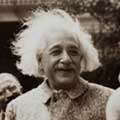 Einstein's
generalized theory of gravitation is a universal mathematical approach to
field theory. He investigated reducing the different phenomena by the process
of logic to something already known or evident. Einstein tried to unify
gravity and electromagnetism in a way that also led to a new subtle understanding
of quantum mechanics.
Einstein's
generalized theory of gravitation is a universal mathematical approach to
field theory. He investigated reducing the different phenomena by the process
of logic to something already known or evident. Einstein tried to unify
gravity and electromagnetism in a way that also led to a new subtle understanding
of quantum mechanics.Einstein assumed a four-dimensional space-time continuum expressed in axioms represented by five component vectors. Particles appear in his research as a limited region in space in which the field strength or the energy density are particularly high. Einstein treated subatomic particles as objects embedded in the unified field, influencing it and existing as an essential constituent of the unified field but not of it. Einstein also investigated a natural generalization of symmetrical tensor fields, treating the combination of two parts of the field as being a natural procedure of the total field and not the symmetrical and antisymmetrical parts separately. He researched a way to delineate the equations and systems to be derived from a variational principle.
 Einstein
became increasingly isolated in his research on a generalized theory of
gravitation and was ultimately unsuccessful in his attempts.
Einstein
became increasingly isolated in his research on a generalized theory of
gravitation and was ultimately unsuccessful in his attempts.In 1948, Einstein served on the original committee which resulted in the founding of Brandeis University. In 1952, the Israeli government proposed to Einstein that he take the post of second president. He declined the offer, and remains the only United States citizen to ever be offered a position as a foreign head of state. On March 30, 1953, Einstein released a revised unified field theory.
He died in his sleep at a hospital in Princeton, New Jersey on April 18, 1955, leaving the Generalized Theory of Gravitation unsolved. The only person present at his deathbed, a hospital nurse, said that just before his death he mumbled several words in German that she did not understand. He was cremated without ceremony on the same day he died at Trenton, New Jersey in accordance with his wishes. His ashes were scattered at an undisclosed location.
His brain was preserved in a jar by Dr. Thomas Stoltz Harvey, the pathologist who performed the autopsy on Einstein. Harvey found nothing unusual with his brain, but in 1999 further analysis by a team at McMaster University revealed that his parietal operculum region was missing and, to compensate, his inferior parietal lobe was 15% wider than normal. The inferior parietal region is responsible for mathematical thought, visuospatial cognition, and imagery of movement.
http://en.wikipedia.org/wiki/Albert_einstein
James Prescott Joule FRS ( /ˈdʒuːl/;[1] 24 December 1818 – 11 October 1889) was an English physicist and brewer, born in Salford, Lancashire. Joule studied the nature of heat, and discovered its relationship to mechanical work (see energy). This led to the theory of conservation of energy, which led to the development of the first law of thermodynamics. The SI derived unit of energy, the joule, is named after him. He worked with Lord Kelvin to develop the absolute scale of temperature, made observations on magnetostriction, and found the relationship between the current through resistance and the heat dissipated, now called Joule's law.
/ˈdʒuːl/;[1] 24 December 1818 – 11 October 1889) was an English physicist and brewer, born in Salford, Lancashire. Joule studied the nature of heat, and discovered its relationship to mechanical work (see energy). This led to the theory of conservation of energy, which led to the development of the first law of thermodynamics. The SI derived unit of energy, the joule, is named after him. He worked with Lord Kelvin to develop the absolute scale of temperature, made observations on magnetostriction, and found the relationship between the current through resistance and the heat dissipated, now called Joule's law.
Joule became a manager of the brewery[4] and took an active role until the sale of the business in 1854. Science was a hobby but he soon started to investigate the feasibility of replacing the brewery's steam engines with the newly invented electric motor. In 1838, his first scientific papers on electricity were contributed to Annals of Electricity, the scientific journal founded and operated by Davies's colleague William Sturgeon. He formulated Joule's laws in 1840[5] and hoped to impress the Royal Society but found, not for the last time, that he was perceived as a mere provincial dilettante. When Sturgeon moved to Manchester in 1840, Joule and he became the nucleus of a circle of the city's intellectuals. The pair shared similar sympathies that science and theology could and should be integrated. Joule went on to lecture at Sturgeon's Royal Victoria Gallery of Practical Science.[3]
He went on to realise that burning a pound of coal in a steam engine produced five times as much duty as a pound of zinc consumed in a Grove cell,[6] an early electric battery.[7] Joule's common standard of "economical duty" was the ability to raise one pound by a height of one foot, the foot-pound.[3][8]
Joule was influenced by the thinking of Franz Aepinus and tried to explain the phenomena of electricity and magnetism in terms of atoms surrounded by a "calorific ether in a state of vibration".[3]
However, Joule's interest diverted from the narrow financial question to that of how much work could be extracted from a given source, leading him to speculate about the convertibility of energy. In 1843 he published results of experiments showing that the heating effect he had quantified in 1841 was due to generation of heat in the conductor and not its transfer from another part of the equipment.[9] This was a direct challenge to the caloric theory which held that heat could neither be created nor destroyed. Caloric theory had dominated thinking in the science of heat since it was introduced by Antoine Lavoisier in 1783. Lavoisier's prestige and the practical success of Sadi Carnot's caloric theory of the heat engine since 1824 ensured that the young Joule, working outside either academia or the engineering profession, had a difficult road ahead. Supporters of the caloric theory readily pointed to the symmetry of the Peltier-Seebeck effect to claim that heat and current were convertible, at least approximately, by a reversible process.[3]
Further experiments and measurements by Joule led him to estimate the mechanical equivalent of heat as 838 ft·lbf of work to raise the temperature of a pound of water by one degree Fahrenheit.[11] He announced his results at a meeting of the chemical section of the British Association for the Advancement of Science in Cork in 1843 and was met by silence.
Joule was undaunted and started to seek a purely mechanical demonstration of the conversion of work into heat. By forcing water through a perforated cylinder, he was able to measure the slight viscous heating of the fluid. He obtained a mechanical equivalent of 770 ft·lbf/Btu (4.14 J/cal). The fact that the values obtained both by electrical and purely mechanical means were in agreement to at least one order of magnitude was, to Joule, compelling evidence of the reality of the convertibility of work into heat.
Joule now tried a third route. He measured the heat generated against the work done in compressing a gas. He obtained a mechanical equivalent of 823 ft·lbf/Btu (4.43 J/cal).[12] In many ways, this experiment offered the easiest target for Joule's critics but Joule disposed of the anticipated objections by clever experimentation. However, his paper was rejected by the Royal Society and he had to be content with publishing in the Philosophical Magazine. In the paper he was forthright in his rejection of the caloric reasoning of Carnot and Émile Clapeyron, but his theological motivations also became evident:
In 1850, Joule published a refined measurement of 772.692 ft·lbf/Btu (4.159 J/cal), closer to twentieth century estimates.[14]
However, in Germany, Hermann Helmholtz became aware both of Joule's work and the similar 1842 work of Julius Robert von Mayer. Though both men had been neglected since their respective publications, Helmholtz's definitive 1847 declaration of the conservation of energy credited them both.
Also in 1847, another of Joule's presentations at the British Association in Oxford was attended by George Gabriel Stokes, Michael Faraday, and the precocious and maverick William Thomson, later to become Lord Kelvin, who had just been appointed professor of natural philosophy at the University of Glasgow. Stokes was "inclined to be a Joulite" and Faraday was "much struck with it" though he harboured doubts. Thomson was intrigued but skeptical.
Unanticipated, Thomson and Joule met later that year in Chamonix. Joule married Amelia Grimes on 18 August and the couple went on honeymoon. Marital enthusiasm notwithstanding, Joule and Thomson arranged to attempt an experiment a few days later to measure the temperature difference between the top and bottom of the Cascade de Sallanches waterfall, though this subsequently proved impractical.
Though Thomson felt that Joule's results demanded theoretical explanation, he retreated into a spirited defense of the Carnot-Clapeyron school. In his 1848 account of absolute temperature, Thomson wrote that "the conversion of heat (or caloric) into mechanical effect is probably impossible, certainly undiscovered"[16] - but a footnote signaled his first doubts about the caloric theory, referring to Joule's "very remarkable discoveries". Surprisingly, Thomson did not send Joule a copy of his paper but when Joule eventually read it he wrote to Thomson on 6 October, claiming that his studies had demonstrated conversion of heat into work but that he was planning further experiments. Thomson replied on the 27th, revealing that he was planning his own experiments and hoping for a reconciliation of their two views. Though Thomson conducted no new experiments, over the next two years he became increasingly dissatisfied with Carnot's theory and convinced of Joule's. In his 1851 paper, Thomson was willing to go no further than a compromise and declared "the whole theory of the motive power of heat is founded on ... two ... propositions, due respectively to Joule, and to Carnot and Clausius".
As soon as Joule read the paper he wrote to Thomson with his comments and questions. Thus began a fruitful, though largely epistolary, collaboration between the two men, Joule conducting experiments, Thomson analysing the results and suggesting further experiments. The collaboration lasted from 1852 to 1856, its discoveries including the Joule-Thomson effect, and the published results did much to bring about general acceptance of Joule's work and the kinetic theory.
Joule perceived the relationship between his discoveries and the kinetic theory of heat. His laboratory notebooks reveal that he believed heat to be a form of rotational, rather than translational motion.
Joule could not resist finding antecedents of his views in Francis Bacon, Sir Isaac Newton, John Locke, Benjamin Thompson (Count Rumford) and Sir Humphry Davy. Though such views are justified, Joule went on to estimate a value for the mechanical equivalent of heat of 1034 foot-pound from Rumford's publications. Some modern writers have criticised this approach on the grounds that Rumford's experiments in no way represented systematic quantitative measurements. In one of his personal notes, Joule contends that Mayer's measurement was no more accurate than Rumford's, perhaps in the hope that Mayer had not anticipated his own work. Joule is attributed with explaining the Green Flash phenomenon in a letter to the Manchester Literary and Philosophical Society in 1869.
 Joule died at home in Sale[17] and is buried in Brooklands
cemetery there. The gravestone is inscribed with the number "772.55",
his climacteric 1878 measurement of the mechanical equivalent of heat,
and with a quotation from the Gospel of John, "I must work the works of him that sent me, while it is day: the night cometh, when no man can work" (9:4).
Joule died at home in Sale[17] and is buried in Brooklands
cemetery there. The gravestone is inscribed with the number "772.55",
his climacteric 1878 measurement of the mechanical equivalent of heat,
and with a quotation from the Gospel of John, "I must work the works of him that sent me, while it is day: the night cometh, when no man can work" (9:4).
James Prescott Joule
From Wikipedia, the free encyclopedia
| James Prescott Joule | |
|---|---|
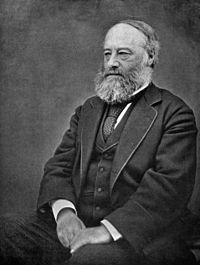
James Joule - Physicist
|
|
| Born | 24 December 1818 Salford, Lancashire, England, UK |
| Died | 11 October 1889 (aged 70) Sale, Cheshire, England, UK |
| Citizenship | British |
| Fields | Physics |
| Known for | First Law of Thermodynamics |
| Influences | John Dalton John Davies |
Contents[hide] |
[edit] Early years
The son of Benjamin Joule (1784–1858), a wealthy brewer, and Alice Prescott Joule, James Prescott Joule was born in the house adjoining the Joule Brewery in New Bailey Street, Salford 24 December 1818.[2] James was tutored at the family home 'Broomhill', Pendlebury, near Salford, until 1834 when he was sent with his elder brother Benjamin, to study with John Dalton at the Manchester Literary and Philosophical Society.[2] The pair only received two years' education in arithmetic and geometry before Dalton was forced to retire owing to a stroke. However, Dalton's influence made a lasting impression as did that of his associates, chemist William Henry and Manchester engineers Peter Ewart and Eaton Hodgkinson. Joule was subsequently tutored by John Davies. Fascinated by electricity, he and his brother experimented by giving electric shocks to each other and to the family's servants.[3]Joule became a manager of the brewery[4] and took an active role until the sale of the business in 1854. Science was a hobby but he soon started to investigate the feasibility of replacing the brewery's steam engines with the newly invented electric motor. In 1838, his first scientific papers on electricity were contributed to Annals of Electricity, the scientific journal founded and operated by Davies's colleague William Sturgeon. He formulated Joule's laws in 1840[5] and hoped to impress the Royal Society but found, not for the last time, that he was perceived as a mere provincial dilettante. When Sturgeon moved to Manchester in 1840, Joule and he became the nucleus of a circle of the city's intellectuals. The pair shared similar sympathies that science and theology could and should be integrated. Joule went on to lecture at Sturgeon's Royal Victoria Gallery of Practical Science.[3]
He went on to realise that burning a pound of coal in a steam engine produced five times as much duty as a pound of zinc consumed in a Grove cell,[6] an early electric battery.[7] Joule's common standard of "economical duty" was the ability to raise one pound by a height of one foot, the foot-pound.[3][8]
Joule was influenced by the thinking of Franz Aepinus and tried to explain the phenomena of electricity and magnetism in terms of atoms surrounded by a "calorific ether in a state of vibration".[3]
However, Joule's interest diverted from the narrow financial question to that of how much work could be extracted from a given source, leading him to speculate about the convertibility of energy. In 1843 he published results of experiments showing that the heating effect he had quantified in 1841 was due to generation of heat in the conductor and not its transfer from another part of the equipment.[9] This was a direct challenge to the caloric theory which held that heat could neither be created nor destroyed. Caloric theory had dominated thinking in the science of heat since it was introduced by Antoine Lavoisier in 1783. Lavoisier's prestige and the practical success of Sadi Carnot's caloric theory of the heat engine since 1824 ensured that the young Joule, working outside either academia or the engineering profession, had a difficult road ahead. Supporters of the caloric theory readily pointed to the symmetry of the Peltier-Seebeck effect to claim that heat and current were convertible, at least approximately, by a reversible process.[3]
[edit] The mechanical equivalent of heat
Joule wrote in his 1845 paper:... the mechanical power exerted in turning a magneto-electric machine is converted into the heat evolved by the passage of the currents of induction through its coils; and, on the other hand, that the motive power of the electro-magnetic engine is obtained at the expense of the heat due to the chemical reactions of the battery by which it is worked.[10]Joule here adopts the language of vis viva (energy), possibly because Hodgkinson had read a review of Ewart's On the measure of moving force to the Literary and Philosophical Society in April 1844.
Further experiments and measurements by Joule led him to estimate the mechanical equivalent of heat as 838 ft·lbf of work to raise the temperature of a pound of water by one degree Fahrenheit.[11] He announced his results at a meeting of the chemical section of the British Association for the Advancement of Science in Cork in 1843 and was met by silence.
Joule was undaunted and started to seek a purely mechanical demonstration of the conversion of work into heat. By forcing water through a perforated cylinder, he was able to measure the slight viscous heating of the fluid. He obtained a mechanical equivalent of 770 ft·lbf/Btu (4.14 J/cal). The fact that the values obtained both by electrical and purely mechanical means were in agreement to at least one order of magnitude was, to Joule, compelling evidence of the reality of the convertibility of work into heat.
Joule now tried a third route. He measured the heat generated against the work done in compressing a gas. He obtained a mechanical equivalent of 823 ft·lbf/Btu (4.43 J/cal).[12] In many ways, this experiment offered the easiest target for Joule's critics but Joule disposed of the anticipated objections by clever experimentation. However, his paper was rejected by the Royal Society and he had to be content with publishing in the Philosophical Magazine. In the paper he was forthright in his rejection of the caloric reasoning of Carnot and Émile Clapeyron, but his theological motivations also became evident:
I conceive that this theory ... is opposed to the recognised principles of philosophy because it leads to the conclusion that vis viva may be destroyed by an improper disposition of the apparatus: Thus Mr Clapeyron draws the inference that 'the temperature of the fire being 1000°C to 2000°C higher than that of the boiler there is an enormous loss of vis viva in the passage of the heat from the furnace to the boiler.' Believing that the power to destroy belongs to the Creator alone I affirm ... that any theory which, when carried out, demands the annihilation of force, is necessarily erroneous.In 1845, Joule read his paper On the mechanical equivalent of heat to the British Association meeting in Cambridge.[13] In this work, he reported his best-known experiment, involving the use of a falling weight, in which gravity does the mechanical work, to spin a paddle-wheel in an insulated barrel of water which increased the temperature. He now estimated a mechanical equivalent of 819 ft·lbf/Btu (4.41 J/cal).
In 1850, Joule published a refined measurement of 772.692 ft·lbf/Btu (4.159 J/cal), closer to twentieth century estimates.[14]
[edit] Reception and priority
- For the controversy over priority with Mayer, see Mechanical equivalent of heat: Priority
However, in Germany, Hermann Helmholtz became aware both of Joule's work and the similar 1842 work of Julius Robert von Mayer. Though both men had been neglected since their respective publications, Helmholtz's definitive 1847 declaration of the conservation of energy credited them both.
Also in 1847, another of Joule's presentations at the British Association in Oxford was attended by George Gabriel Stokes, Michael Faraday, and the precocious and maverick William Thomson, later to become Lord Kelvin, who had just been appointed professor of natural philosophy at the University of Glasgow. Stokes was "inclined to be a Joulite" and Faraday was "much struck with it" though he harboured doubts. Thomson was intrigued but skeptical.
Unanticipated, Thomson and Joule met later that year in Chamonix. Joule married Amelia Grimes on 18 August and the couple went on honeymoon. Marital enthusiasm notwithstanding, Joule and Thomson arranged to attempt an experiment a few days later to measure the temperature difference between the top and bottom of the Cascade de Sallanches waterfall, though this subsequently proved impractical.
Though Thomson felt that Joule's results demanded theoretical explanation, he retreated into a spirited defense of the Carnot-Clapeyron school. In his 1848 account of absolute temperature, Thomson wrote that "the conversion of heat (or caloric) into mechanical effect is probably impossible, certainly undiscovered"[16] - but a footnote signaled his first doubts about the caloric theory, referring to Joule's "very remarkable discoveries". Surprisingly, Thomson did not send Joule a copy of his paper but when Joule eventually read it he wrote to Thomson on 6 October, claiming that his studies had demonstrated conversion of heat into work but that he was planning further experiments. Thomson replied on the 27th, revealing that he was planning his own experiments and hoping for a reconciliation of their two views. Though Thomson conducted no new experiments, over the next two years he became increasingly dissatisfied with Carnot's theory and convinced of Joule's. In his 1851 paper, Thomson was willing to go no further than a compromise and declared "the whole theory of the motive power of heat is founded on ... two ... propositions, due respectively to Joule, and to Carnot and Clausius".
As soon as Joule read the paper he wrote to Thomson with his comments and questions. Thus began a fruitful, though largely epistolary, collaboration between the two men, Joule conducting experiments, Thomson analysing the results and suggesting further experiments. The collaboration lasted from 1852 to 1856, its discoveries including the Joule-Thomson effect, and the published results did much to bring about general acceptance of Joule's work and the kinetic theory.
[edit] Kinetic theory
Kinetics is the science of motion. Joule was a pupil of Dalton and it is no surprise that he had learned a firm belief in the atomic theory, even though there were many scientists of his time who were still sceptical. He had also been one of the few people receptive to the neglected work of John Herapath on the kinetic theory of gases. He was further profoundly influenced by Peter Ewart's 1813 paper On the measure of moving force.Joule perceived the relationship between his discoveries and the kinetic theory of heat. His laboratory notebooks reveal that he believed heat to be a form of rotational, rather than translational motion.
Joule could not resist finding antecedents of his views in Francis Bacon, Sir Isaac Newton, John Locke, Benjamin Thompson (Count Rumford) and Sir Humphry Davy. Though such views are justified, Joule went on to estimate a value for the mechanical equivalent of heat of 1034 foot-pound from Rumford's publications. Some modern writers have criticised this approach on the grounds that Rumford's experiments in no way represented systematic quantitative measurements. In one of his personal notes, Joule contends that Mayer's measurement was no more accurate than Rumford's, perhaps in the hope that Mayer had not anticipated his own work. Joule is attributed with explaining the Green Flash phenomenon in a letter to the Manchester Literary and Philosophical Society in 1869.
[edit] Honours

A statue of Joule in the Manchester Town Hall
- Fellow of the Royal Society, (1850);
- Royal Medal, (1852);
- Copley Medal (1870);
- President of Manchester Literary and Philosophical Society, (1860);
- President of the British Association for the Advancement of Science, (1872, 1887);
- Honorary degrees:
- LL.D., Trinity College Dublin, (1857);
- DCL, University of Oxford, (1860);
- LL.D., University of Edinburgh, (1871).
- He received a civil list pension of £200 per annum in 1878 for services to science;
- Albert Medal of the Royal Society of Arts, (1880).
- There is a memorial to Joule in the north choir aisle of Westminster Abbey, though he is not buried there, contrary to what some biographies state.
- A statue by Alfred Gilbert, stands in Manchester Town Hall, opposite that of Dalton.
- There is a Wetherspoon's pub named after him in the centre of Sale
[edit] Selected writings
- Joule, J. P. (1963). The Scientific Papers of James Prescott Joule. London: Dawsons of Pall Mall.
[edit] Notes
- ^ OED: "Although some people of this name call themselves (dʒaʊl), and others (dʒəʊl) [the OED format for /ˈdʒoʊl/], it is almost certain that J. P. Joule (and at least some of his relatives) used (dʒuːl). The Joule brewery used the confusion in its pronunciation in advertising: Childs, Stephen. "Chemical Miscellany". Chemistry in Action! (University of Limerick) (50). Retrieved 24 March 2010.
- ^ a b Hulme, Charles (2010). "John Cassidy:Manchester Sculptor". John Cassidy 150th Anniversary website. Retrieved 22 March 2010.
- ^ a b c d e Smith (2004)
- ^ http://www.joulesbrewery.co.uk/brewery/joules_story.php
- ^ Joule, J.P. (1841) "On the heat evolved by metallic conductors of electricity" Philosophical Magazine, 19, 260; Scientific Papers 65
- ^ William Robert Grove was to give one of the earliest general accounts of the conservation of energy in 1844.
- ^ Smith (1998) p.60
- ^ Joule's unit of the foot-pound corresponds to a modern measure of energy. The energy required to raise a mass, m, through a height h is mgh, where g is the standard gravity. Joule's unit is dimensionally correct if interpreted as foot-pound force. Where SI units are employed, such energy is given in terms of the eponymous joule: 1 foot-pound = 1.356 J.
- ^ Joule, James Prescott (1843). "On the calorific effects of magneto-electricity, and on the mechanical value of heat". Philosophical Magazine, Series 3 23: 263–276.
- ^ Joule, James Prescott (1845). "On the Changes of Temperature Produced by the Rarefaction and Condensation of Air". Philosophical Magazine, Series 3 (Harper & brothers) 26: 369.
- ^ Joule's unit corresponds to 5.3803×10−3 J/cal. Thus Joule's estimate was 4.51 J/cal, compared to the value accepted by the beginning of the 20th century of 4.1860 J/cal (M.W. Zemansky (1968) Heat and Thermodynamics, 5th ed., p. 86).
- ^ Joule, J.P. (1845) "On the rarefaction and condensation of air" Philosophical Magazine, Scientific Papers 172
- ^ Joule, J.P. (1845) "On the Mechanical Equivalent of Heat", Brit. Assoc. Rep., trans. Chemical Sect, p.31, read before the British Association at Cambridge, June
- ^ Joule, J.P (1 January 1850) "On the mechanical equivalent of heat," Philosophical Transactions of the Royal Society of London, vol.140, Part 1, pages 61–82.
- ^ Sibum (1994)
- ^ See Thomson, William (1848). "On an Absolute Thermometric Scale founded on Carnot's Theory of the Motive Power of Heat, and calculated from Regnault's Observations". Philosophical Journal.- See also the account in Thomson, William (1882). Mathematical and Physical Papers. Cambridge, England: Cambridge University Press. pp. 100–106.
- ^ GRO Register of Deaths: DEC 1889 8a 121 ALTRINCHAM - James Prescott Joule
[edit] Further reading
- Bottomley, J. T. (1882). "James Prescott Joule". Nature 26 (678): 617–620. Bibcode 1882Natur..26..617B. doi:10.1038/026617a0.
- Cardwell, D. S. L. (1991). James Joule: A Biography. Manchester college Press. ISBN 0-7190-3479-5.
- Forrester, J. (1975). "Chemistry and the Conservation of Energy: The Work of James Prescott Joule". Studies in the History and Philosophy of Science 6 (4): 273–313. doi:10.1016/0039-3681(75)90025-4.
- Fox, R, "James Prescott Joule, 1818–1889", in North, J. (1969). Mid-nineteenth-century scientists. Elsevier. pp. 72–103. ISBN 0-7190-3479-5.
- Reynolds, Osbourne (1892). Memoir of James Prescott Joule. Manchester, England: Manchester Literary and Philosophical Society. Retrieved 2008-03-15.
- Sibum, H. O. (1995). "Reworking the mechanical value of heat: instruments of precision and gestures of accuracy in early Victorian England". Studies in History and Philosophy of Science 26: 73–106. doi:10.1016/0039-3681(94)00036-9.
- Smith, C. (1998). The Science of Energy: A Cultural History of Energy Physics in Victorian Britain. London: Heinemann. ISBN 0-485-11431-3.
- Smith, Crosbie, "Joule, James Prescott", on the website of the Oxford Dictionary of National Biography (Subscription or UK public library membership required). The first edition of this text is available as an article on Wikisource:
 "Joule, James Prescott". Dictionary of National Biography. London: Smith, Elder & Co. 1885–1900.
"Joule, James Prescott". Dictionary of National Biography. London: Smith, Elder & Co. 1885–1900. - Smith, C. & Wise, M.N. (1989). Energy and Empire: A Biographical Study of Lord Kelvin. Cambridge University Press. ISBN 0-521-26173-2.
- Steffens, H.J. (1979). James Prescott Joule and the Concept of Energy. Watson. ISBN 0-88202-170-2.
- Walker, James (1950). Physics 4th Edition. Pearson. ISBN 978-0-321-54163-5.
[edit] External links
| Wikimedia Commons has media related to: |
| Wikisource has original works written by or about: James Prescott Joule |
- Classic papers of 1845 and 1847 at ChemTeam website On the Mechanical Equivalent of Heat and On the Existence of an Equivalent Relation between Heat and the ordinary Forms of Mechanical Power
- Joule's water friction apparatus at London Science Museum
- Some Remarks on Heat and the Constitution of Elastic Fluids, Joule's 1851 estimate of the speed of a gas molecule.
- University of Manchester material on Joule - includes photographs of Joule's house and gravesite
 "Joule, John Prescott". Dictionary of National Biography. London: Smith, Elder & Co. 1885–1900.
"Joule, John Prescott". Dictionary of National Biography. London: Smith, Elder & Co. 1885–1900.- "Dr. Joule". Electrical Engineer (London: Biggs & Co) (October 18): 311–312. 1889. Retrieved 2008-05-16.- obituary with brief comment on Joule's fam



